By John Helmer, Moscow
There is no word in the language of Australian soldiers or sailors for tit-for-tat.
American military strategists, the uniform and the armchair types, are much better acquainted. The latter understand exactly why a squadron of the Russian Pacific Fleet has sailed to a position within helicopter (and nuclear-armed missile) range of Brisbane, ahead of President Vladimir Putin’s visit to the G20 state summit over the weekend.
In the version of game theory for which Thomas Schelling, the American strategist, won the Nobel Prize in 2005, the optimal way to deter an enemy from going to war is to duplicate his threats of coercion and violence, and match his uncertainty, so that coordinated deterrence and defence would be preferable to first-strike attacks. The objective of the game for both sides, Schelling argued, is collaboration “implicitly, if not explicitly, in avoiding the kinds of crises in which withdrawal is intolerable for both sides, in avoiding false alarms and mistaken intentions, and in providing…reassurance that restraint on the part of potential enemies will be matched by restraint of our own.”*
What the Russian Navy is doing in the Coral Sea, off Brisbane, Moscow sources believe, is to match exactly what the US Navy did in the Black Sea, off Sochi last February. Igor Korotchenko, editor-in-chief of National Defense Magazine, comments: “In the West, they are engaging in provocation at the moment — there is a process of demonizing Russia. Ships of the Russian Navy may be there, where they want to be. We have a right to be there. We do not have to answer to anyone. In Australia, in particular, the Prime Minister is hysterical about Russia, about Putin.”
What the Australian Government doesn’t understand, another source adds, is that in the classic game of Prisoner’s Dilemma, as Moscow played it with Washington during the Cold War, “the Australians aren’t players. They are the prisoners of the Americans.”
Australian Government threats to Putin’s security in Brisbane were reported in September [2], when they temporarily lifted domestic poll ratings for the prime minister, Tony Abbott (below left), and foreign minister, Julie Bishop. Since Abbott’s threat to “shirt-front” (attack) Putin, disapproval by Australian voters of Abbott’s performance as prime minister has grown from 48% to 50%. If an election were held this weekend, Abbott’s party would lose power [3]. Abbott’s meeting with Putin in Beijing early this week lasted 15 minutes – not enough time for what Abbott’s press releases claim he had to say [4].
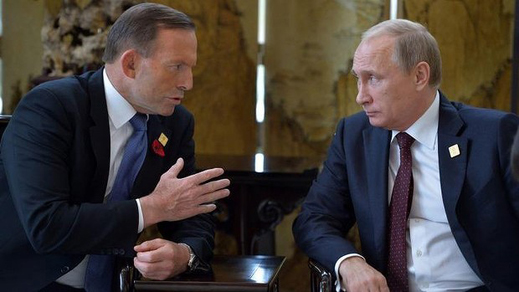
Over the past 24 hours the Australian media have been reporting what a Sydney newssheet calls “a fleet of warships [headed] towards Australia in an apparent display of muscle-flexing ahead of the G20 meeting amid tensions between the two countries over the MH17 crash.” Two Australian Navy frigates, smaller and under-armed in relation to the Russian warships, were announced as on their way to observe the squadron.
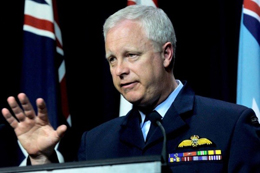 A local military officer named Mark Binskin (right) made a disparaging reference to the capabilities of the Russian squadron. “Their confidence? One of them is an ocean-going tug. It’s just part of their operation. They are in international waters. They are allowed to do that. They are in our approaches and we will continue to surveil them with air and maritime assets.” The official started as a naval pilot, and after running operations in Iraq was promoted to head the Australian air force, then the combined Australian defence forces.
A local military officer named Mark Binskin (right) made a disparaging reference to the capabilities of the Russian squadron. “Their confidence? One of them is an ocean-going tug. It’s just part of their operation. They are in international waters. They are allowed to do that. They are in our approaches and we will continue to surveil them with air and maritime assets.” The official started as a naval pilot, and after running operations in Iraq was promoted to head the Australian air force, then the combined Australian defence forces.
The Russian Navy has been within shooting and surveil distance of the Australian coast already this year. In April, the Shaposhnikov and two escorts had sailed to Indonesia to participate in a multi-navy exercise called Komodo-2014 [5]. The Indonesian Navy reported at the time that an Australian squadron had been invited, but cancelled at the last minute on account of “political problems [6]”. After Komodo the Shaposhnikov sailed westwards across the Indian Ocean to take up an anti-piracy patrol in the Gulf of Aden, with a rest-and-recreation stop at Victoria, in the Seychelles. For more on the Russian Navy’s piracy patrols in this region, read this [7].
On October 24, the Pacific Fleet’s spokesman in Vladivostok announced that the Varyag would sail to Australia, escorted by the Shaposhnikov and two auxiliaries, the Butoma and the Fotiy Krilov.
On November 11 — 4,400 nautical miles southwards at about 14 knots per hour — this is how a Sydney newspaper [8] reported the names and locations of the “fleet”:
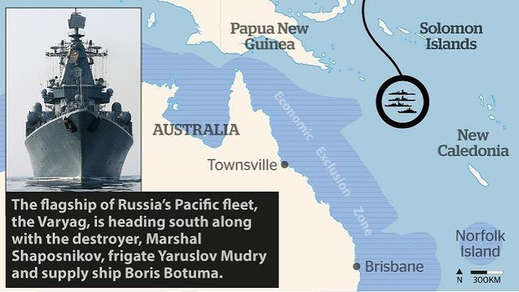
Here is the Wikipedia list of the Russian Navy’s active-service fleets, properly spelled [9]. According to the Australian media, the squadron off Australia comprises the Varyag (lead image, left) , the Shaposhnikov (below 1), the Yaroslav Mudriy (2), and the fleet oiler, Boris Butoma (3).

The Australian media ought to be able to spell the names. The squadron was scheduled to visit Sydney for an international fleet review, a display to commemorate the founding of the British colony in October 2013, and confirmed two months earlier by a Russian news agency [10]. Then the Australian Defence Ministry announced [11] the Russian fleet had cancelled its appearance “due [to] a change in the positioning of the Russian ships.”
In the latest Australian media handouts, there has been an intelligence failure. The destroyer frigate Mudriy has been confused with the fleet rescue and salvage tug, Fotiy Krilov [12].
Under way, the Fotiy Krilov is red, with its name painted in white Roman-alphabet letters at the bow, so that even an air marshal in Canberra can tell and spell the difference from the Mudriy whose grey port and starboard sides carry only the numerical identifier, 727:
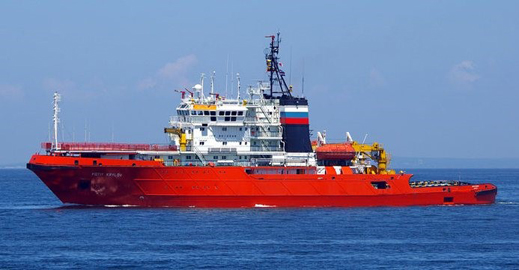
The US Navy has been able to tell the difference for two years. The Fotiy Krilov was recorded in the Russian squadron participating RIMPAC-2012, a US naval exercise off the Hawaian islands [13].
Two years before, the Varyag had been invited to San Francisco to commemorate the 1863 deployment of a Russian naval squadron in San Francisco Bay to support the Union side in the American Civil War, and deter British schemes to recognize the Confederacy and blockade California [14].
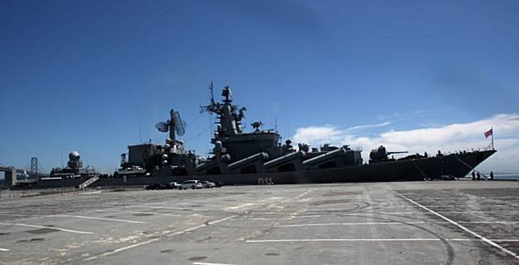
The missile-firing cannisters visible along the cruiser’s side are rated for launching the P-1000 Vulkan, a cruise missile with range of at least 500 kms, a speed of at least Mach 2.5, and a warhead of nuclear or conventional explosive with a yield of 350 kilotonnes. For a shirtfront with this weapon, Australia has no defence.

Source: http://upload.wikimedia.org/wikipedia/commons/thumb/c/c8/P-500_bazalt_sketch.svg/1412px-P-500_bazalt_sketch.svg.png [15]
Russian military sources in Moscow believe that the Russian Navy may also be deploying nuclear-armed submarines in the Coral Sea to reinforce the surface squadron and counter US Navy submarines in the area. A spoof version of this new “battle of the Coral Sea” – 72 years after the Japanese Navy defeat in the area — can be read here [16].
Off the Australian coast this morning, the ships in the Russian squadron display helicopters with enough ship-to-shore range to reach Brisbane and back. That would be in the event Russian officials in Putin’s delegation attending the G20 summit call for security evacuation.
The Russian move matches the US Navy deployment in the Black Sea in February. At that time the USS Mount Whitney,(lead image right) flagship of the US Sixth (Mediterranean) Fleet, took up a position off Sochi during the Winter Olympics for what State Department and Pentagon officials claimed to be security and evacuation standby. According to the State Department [17], “the Department of Defense and others have made various announcements about different resources that will be provided… our focus is on keeping American citizens up to date…making sure we’re protecting our athletes.”
The Pentagon spokesman Rear Admiral John Kirby explained [18]: “they’re in the Black Sea as we — as we said they would be. It’s routine for us to be operating in the Black Sea. They are going to conduct port visits, they’re going to be doing training, multiple missions inside the Black Sea. Again, that’s — that’s routine. ..Navy ships all over the world are available for multiple tasking and should there be a need for them with respect to the Olympics, they’re obviously — they’re assets that could be called upon, should they be the right asset, and should the State Department need that help.” Kirby added: “there’s been no request for that. There’s no demand signal for that right now. The European commander — European command commander does what every combatant commander does every day, and that’s take a look at the assets that he has available to him for any wide range of military tasking.” For the detailed story reported at the time, read this [19].
Alexander Goltz, Moscow-based military analyst for the NATO Defense College, says [20] that Russian naval escorts for presidential summits have happened before. “In Soviet and Russian times, Moscow informed [other governments] in advance of such visits. At this time the Varyag and the squadron came without invitation. There is a reincarnation of the gunboat diplomacy that was so popular in the 19th century. Putin’s views on the world system are strangely not advanced beyond the ‘real politik’ of two centuries ago. Now, being unable to convince its partners, Russia has strangely decided to reinforce its weak position by showing off a few pieces of rusty military equipment. Curiously, Obama isn’t picking up the challenge and is not sending a couple of carrier battle groups to Australian shores. Against them the Russian ships would be at risk of losing a few.”
* Thomas Schelling and Morton Halperin, Strategy and Arms Control, Brasseys, 1985: page 1-2.
